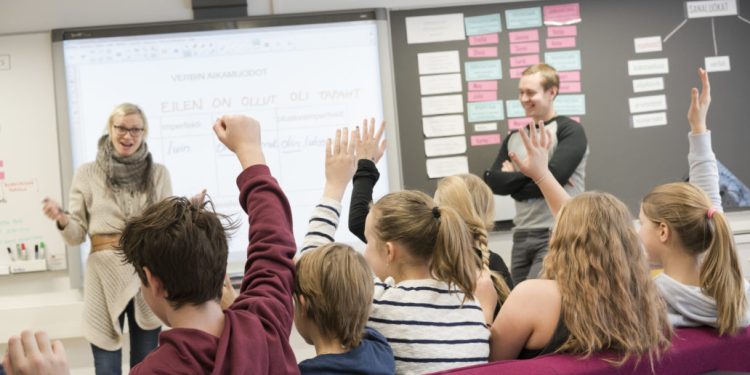oYou don’t need to misunderstand this point, first of all. We are not discussing early education here because in Finland, children typically begin attending school at age 7. However, it relates to early childhood education that parents and nursery kindergartens can provide for children.
Why Finland’s Education System is the best primary school education system
Finland’s Education System
Additionally, parents who choose to enroll their children in kindergarten or not work to instill a love of reading in their children. In this regard, the “maternity package” that the Finnish Social Security Organization offers to new parents includes three books. Three books are given: one to the mother, one to the father, and one to the child who will read it in later years. Yes, you can consider it a positive step in the formation of reading habits in young children.
delayed education
Compared to other nations, Finland begins formal education at age 7. Many educators claim that early school puts too much pressure on students to perform well in their studies, which may be detrimental to their mental health. Because of this, Finland’s educational system favors having students enter the classroom at age 7. However, as we noted in the heading above, parents are also responsible for their children’s early education, and preschools and kindergartens typically provide engaging play activities to help young children under the age of seven develop important study concepts.
Changed Position of Teachers
In contrast to other developed nations, it is not students with average grades who enter the teaching profession. Yes, teaching is difficult, just like other difficult professions, especially when it comes to selection. It is true that only 10% of applicants who apply to become teachers are choosen for the position.
On the other hand, it is different when we discuss the role of teachers in educational institutions. Fortunately, Finland has an acceptable teacher-to-student ratio, and classes typically last 4-5 hours per day. It is also crucial to talk about how teachers use their spare time for planning, meetings, and other activities related to their studies.
Additionally, teachers are not required to stay at the school after their scheduled class times. The Finnish educational system helps teachers perform better by giving them more mental peace.
Fewer or No Assignments
If you compare the amount of homework given to students in developed nations to that in Finland, you’ll quickly see that neither elementary nor secondary schools give students a lot of homework. Even in schools, playing time—like sports, etc.—takes precedence over homework.
The final exam has no homework.
It is usually certain that you will only need to spend 20 to 30 minutes on your homework if you attend a Finnish school.
You are then free to go about your life and explore other options. Hopefully, other educational systems around the world will see this approach as a great way to help students become more effective in all facets of life.
Only collaboration, no rivalry
If you consider the distinctive qualities that make Finland’s educational system one of the best in the world, you shouldn’t overlook the environment they are fostering in the classroom. Yes, it is true that in Finnish schools, students and teachers do not differentiate between a student who performs poorly and the class top student. Students don’t waste their time trying to win competitions in the classroom because of this.
Actually, we should respect this approach taken by Finnish schools because, frequently, these competitions elevate students’ standing in their academic pursuits. Nevertheless, we are subjecting a number of students to superiority complexes. Without a doubt, students simply forget their true academic objectives in the race of competition. Finnish schools are enhancing the idea of helping one another and brotherhood with their theory of cooperation by taking this step of “no competition.” Yes, the Finnish educational system favors student collaboration in the classroom over student competition. This is another important factor in the development of Finland’s educational system.
Affordable & Free Education
In Finland, elementary and middle school education are entirely free. Yes, if you are legally residing in Finland, your child is eligible to enroll in school for free from the age of seven to seventeen. Education is not at all a business in Finland, unlike other developed and developing nations, where state institutions vehemently oppose such practices.
However, if you enroll your child in a private school, you will be required to pay a fee, which is undoubtedly reasonable. When it comes to higher education costs, however, they are also reasonable. Notably, questions about tuition costs at Finnish universities are not asked of students from the EU or EEA.
Additionally, the Finnish government annually offers a number of scholarships to non-EU/EEA citizens, primarily to support PhD students. However, you need not worry if you are a student pursuing a Bachelor’s or Master’s degree because you can easily find numerous other scholarship programs like Erasmus Mundus, etc.
Less testing
Although most of us have heard about how well Finnish students perform in international mathematics and other competitions, it is also true that there aren’t many tests given in Finnish schools. Even their teachers lack the standardized testing preparation of other school systems around the world. In fact, learning is given more importance in Finnish schools than testing, and teachers are well-prepared to do so.
Although the only authorized test is given in the senior year of high school, it’s interesting to note that the results of this required test are also kept confidential. The Finnish educational system also greatly relieves students’ stress related to result announcement in this way. Additionally, it is advises implementing this type of result relief in India, where Telangana alone saw close to 20 students commit suicide following the release of intermediate results in April 2019. Hopefully, the Indian educational system will take our recommendation into account.
Special students attends the same school
Like in other developed nations, Finland does not have special schools for children with special needs. This action sends a strong message to school administrators around the world who make a difference in the lives of children while also demonstrating sincere intentions toward both special needs and regular students. However, the Finnish education system also employs more staff in the form of teachers and nurses to care for these 23% special students.
Fairness between Schools
Because Finns value equal opportunities, their educational systems reflect this. The educational experience in public and private schools is identical. Kids surprisingly prefer attending public schools over private ones, and the public schools’ attendance rate is also impressive. Contrarily, there is no difference in the quality of education provided in public schools, which explains why Finland has so few private schools. Due to the fact that these private schools serve as government agencies, they do not charge much for students.
a desire to learn
In the same vein, Finland is working very hard to instill a love of learning in its children. In a similar vein, students enroll in Finnish universities not only to advance their careers but also to pursue their passion for learning in a particular field. Yes, universities in Finland offer a wide range of elective courses, from pop culture to politics.
Finland on the other hand is making great efforts to elicit a love of learning in children by constructing excellent libraries. In a similar vein, Helsinki, Finland’s Central Library Oodi is among the world’s most cutting-edge public libraries. Another worthwhile library in Finland is Turku City Library.
In a nutshell, the main goal of this discussion is to outline the fundamental causes for Finland’s educational systems’ success. We hoped that our in-depth and well-researched article would help you comprehend. Why Finland has the best educational system in the world. What adjustments you should make in your educational institutions?















